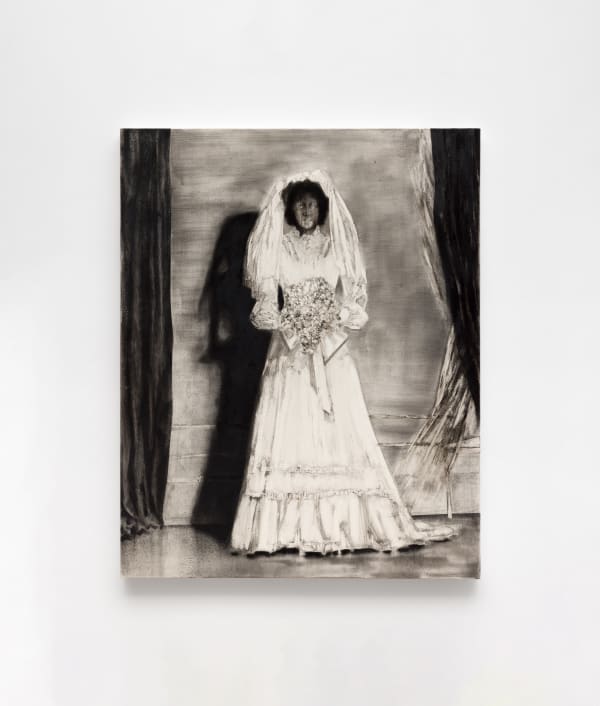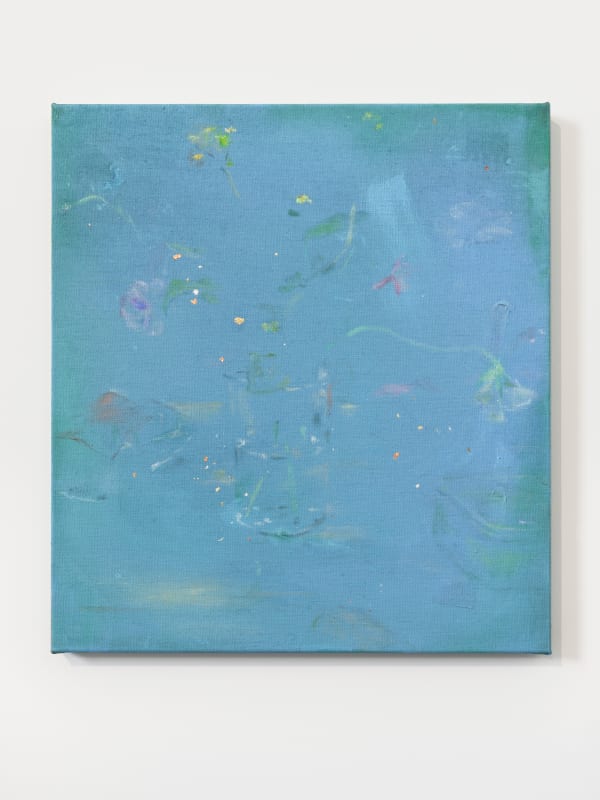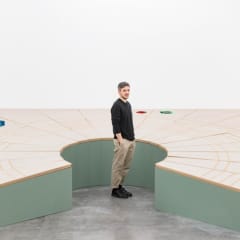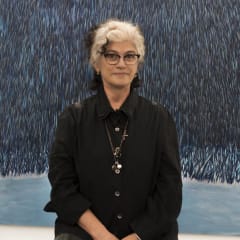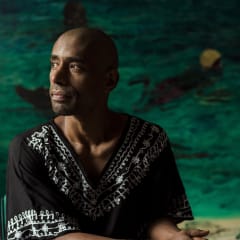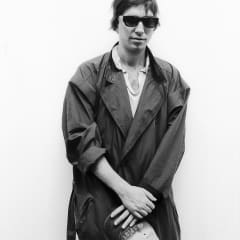Dreaming of Spilliaert Group exhibition
Open everyday | 11am to 6pm
d'Ouwe Kerke
Dorpsstraat 16
4525 AH Retranchement
The Netherlands
Léon Spilliaert, Lucas Arruda, Kasper Bosmans, Varda Caivano, Guglielmo Castelli, Adriano Costa, Lewis Hammond, Vojtěch Kovařík, Mimi Lauter, Patricia Leite, Paulo Nimer Pjota, Antonio Obá, Giangiacomo Rossetti, Maaike Schoorel, Paula Siebra and Pol Taburet.
In Dreaming of Spilliaert Mendes Wood DM presents several astonishing works by Léon Spilliaert (b.1881, Ostend, Belgium; d.1946, Brussels) in combination with no less than fifteen living artists. Exhibited in a 17th-century deconsecrated church in Retranchement, only a few miles away from the North Sea, this transhistorical presentation allows for a multifaceted reading of the artworks on view.
Few Belgian artists remain as ambiguous yet influential as Léon Spilliaert. Today widely recognized for his ominous sea- and landscapes, enigmatic self-portraits and sinister nocturnal scenes, the idiosyncratic artist holds a unique position in the Belgian and international art world. The accumulation of symbolist, romantic and expressionist tendencies into a single body of work resists any singular categorization and vividly highlights an existential, yet universal, reflection. The artistic attitude and themes of Spilliaert serve as a reference for the contemporary artists in Dreaming of Spilliaert and can offer a valid point of entry for the reading of their work.
Throughout the oeuvre of Spilliaert one can discover and unravel a symbiotic relation between the depiction of seemingly banal, everyday objects and an attempt to grasp, or escape, the fragility of daily life. In Les Poupées (1931), for example, the anxious look on the dolls’ eyes transforms the lifeless puppet into a poignant reflection of human vulnerability. What becomes undoubtedly apparent in Spilliaert’s series of compositions with dolls, mainly executed in the first part of the 1930s, is the artist’s endless painted repetition of similar objects, as an excuse to examine form, color and technique. This seriality allows for an almost automatic rendition of the subject matter, which, in turn, gives room for psychological explorations, and can also be found in Spilliaert’s sea- and landscapes. These scenes, which encompass a large majority of the artist’s oeuvre, are rightfully praised for their ability to evoke a sense of melancholy, emptiness and unease. The artist employed this subject matter in an attempt to express an existential anxiety, which stemmed from both his personal character as well as the societal characteristics of the beginning of the 20th century. His unique graphic style, with its emphasis on the horizontal line, near-monochromatic color palette and dramatic use of light and shadow, is strikingly visible in La digue et Kursaal (Ostende) (1909).
That the landscape, as a painterly genre, is often utilized by artists to express or examine a mental state and reality rather than a merely physical one remains applicable till this day. Even though the conditions of our contemporary society have changed severely since the time of Spilliaert, a variety of artists presented in this group show draw on the rich tradition of landscape painting in order to explore the complexities of the human condition. The small-scale paintings of Lucas Arruda, for example, present meditative compositions wherein the depicted scenery can be considered as a mnemonic register that evokes an emotional resonance. Although executed with different techniques and more than a hundred years apart, Arruda’s scene powerfully echoes a similar atmosphere to Spilliaert’s Marine (1900), a unique early work by the artist. Paula Siebra’s Vulto (2024) similarly offers a transient, mental mood. Her depictions of everyday life, which are created with surprisingly similar formal strategies to Spilliaert — such as the use of monochromatic color tones — provide a profound sense of tranquility and introspection.
Although Spilliaert mostly worked on paper, he made roughly fifty works in oil on canvas, the majority of which were produced between 1920 and 1936. An exquisite example is the serene Arbres au crépuscule (1924), in which the artist is able to translate his nightly walks into an atmospheric forest scene. This uncanny ambiance can also be found in Pol Taburet’s Karaoke (2024) or in Guglielmo Castelli’s Coarse Salt (2024), in which vague figures wander the picture plane. Patricia Leite, in contrast, offers the viewer a more pastoral imagery that she describes as “sensations of landscapes”. These intimate manifestations can be perceived as diary-like reflections of her daily life, reminiscent of Spilliaert’s idilic Bateau de pêcheur porté par les vagues (1912 — 1913). Inspired by the time spent in her own garden, Mimi Lauter presents a more abstracted, colorful and vivid image. In her approach, a landscape can represent the potential of life.
A searching for the self or, more specifically, the outer representation thereof, brought us some of the most evocative and sometimes haunting artworks produced by Spilliaert. Through these images, the artist expressed his own sense of fragility and alienation. Although not necessarily self-portraits, the images painted by Lewis Hammond often present a similarly intimate yet alienating depiction of figures. Furthermore, Antonio Obá’s Sentinela III: A noiva (2024) comparably resembles some of Spilliaert’s powerful, unsettling portraits. (Self-)Portraiture, be it in the form of painting one’s own physical image, or in the form of the construction of a painted identity through symbolic references, preoccupies multiple artists in this exhibition. By injecting himself within historical compositions, Giangiacomo Rossetti, for example, claims ownership not only over the referenced paintings, but also over the perception of his own image. Kasper Bosmans, on the other hand, employs a vast register of symbolic references to create his artistic narrative. This ever-expanding oeuvre, which departs from the personal but has a universal resonance, offers, in return, an insight into the identity of the artist.
What becomes increasingly clear is the universal character of Léon Spilliaert’s body of work. The exploration of the human condition through landscape depictions, alongside the examination of identity and its construction through portrayal, can be seen as entryways for interpreting the diverse and unique artistic practices exhibited in Dreaming of Spilliaert.
— Jef Declercq
-
 Léon Spilliaert, Marine, 1900
Léon Spilliaert, Marine, 1900 -
 Lucas Arruda, Untitled (from the Deserto-Modelo series), 2024
Lucas Arruda, Untitled (from the Deserto-Modelo series), 2024 -
 Guglielmo Castelli, Coarse salt, 2024
Guglielmo Castelli, Coarse salt, 2024 -
 Paula Siebra, Vulto, 2024
Paula Siebra, Vulto, 2024 -
 Léon Spilliaert, Nature aux fleurs, 1923
Léon Spilliaert, Nature aux fleurs, 1923 -
 Léon Spilliaert, Silhouette d'arbres en hiver, Hautes Fagnes, 1940
Léon Spilliaert, Silhouette d'arbres en hiver, Hautes Fagnes, 1940 -
 Antonio Obá, Sentinela III: A noiva, 2024
Antonio Obá, Sentinela III: A noiva, 2024 -
 Léon Spilliaert, Arbres au crépuscule, 1924
Léon Spilliaert, Arbres au crépuscule, 1924 -
 Léon Spilliaert, Marine, 1919
Léon Spilliaert, Marine, 1919 -
 Mimi Lauter, Untitled, 2024
Mimi Lauter, Untitled, 2024 -
 Vojtěch Kovařík, Castor tames his horse, 2024
Vojtěch Kovařík, Castor tames his horse, 2024 -
 Léon Spilliaert, Oraison, 1917
Léon Spilliaert, Oraison, 1917 -
 Varda Caivano, Untitled, 2024
Varda Caivano, Untitled, 2024 -
 Patricia Leite, Por Léon Spilliaert, 2024
Patricia Leite, Por Léon Spilliaert, 2024 -
 Pol Taburet, Karaoke, 2024
Pol Taburet, Karaoke, 2024 -
 Léon Spilliaert, La peur du gendarme, 1919
Léon Spilliaert, La peur du gendarme, 1919 -
 Léon Spilliaert, Scène de bal, 1920
Léon Spilliaert, Scène de bal, 1920 -
 Lewis Hammond, something to live for, 2024
Lewis Hammond, something to live for, 2024 -
 Lewis Hammond, Untitled (siren), 2024
Lewis Hammond, Untitled (siren), 2024 -
 Kasper Bosmans, Kitten kisses at night, 2024
Kasper Bosmans, Kitten kisses at night, 2024 -
 Giangiacomo Rossetti, A marriage of doubt and confidence, 2024
Giangiacomo Rossetti, A marriage of doubt and confidence, 2024 -
 Paulo Nimer Pjota, Planta carnívora 2, 2024
Paulo Nimer Pjota, Planta carnívora 2, 2024 -
 Maaike Schoorel, Noon Flowers, 2024
Maaike Schoorel, Noon Flowers, 2024 -
 Léon Spilliaert, La digue et Kursaal (Ostende), 1909
Léon Spilliaert, La digue et Kursaal (Ostende), 1909 -
 Léon Spilliaert, Bateau de pêcheur porté par les vagues, 1912—1913
Léon Spilliaert, Bateau de pêcheur porté par les vagues, 1912—1913 -
 Léon Spilliaert, Dunes, 1928
Léon Spilliaert, Dunes, 1928 -
 Léon Spilliaert, Les poupées, 1931
Léon Spilliaert, Les poupées, 1931 -
 Adriano Costa, PIERRE, Tijelas series | PIERRE, série Tijelas, 2024
Adriano Costa, PIERRE, Tijelas series | PIERRE, série Tijelas, 2024 -
 Adriano Costa, LAZARUSSS Tijelas series | LAZARUSSS série Tijelas, 2024
Adriano Costa, LAZARUSSS Tijelas series | LAZARUSSS série Tijelas, 2024 -
 Adriano Costa, PIERRE, Tijelas series | PIERRE, série Tijelas, 2024
Adriano Costa, PIERRE, Tijelas series | PIERRE, série Tijelas, 2024







